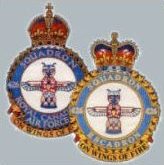Halifax

Powered by four 1675 horsepower Bristol Hercules XVI radial air cooled sleeve valved engines, it had a maximum speed of 278 mph, a service ceiling of 24000 feet, a maximum bombload of 13000 pounds and a range of 1985 miles.
The squadron’s Halifax phase lasted twelve months during which the unit participated in 151 operations and prepared for another seventy-six missions that were canceled. The Thunderbirds launched 2165 sorties of which 1974 were successfully completed. The task was abandoned on 155 sorties with 103 aborted on instructions from the Master Bomber or the Operations’ Centres. Thirty-eight aircraft were lost: twenty-three over enemy territory; four during or shortly after take-off; one Halifax blew up and the crew bailed out of another; one crashed while en route to the target and five crashed while returning from operations; and three were lost in mid-air collisions. In addition, many aircraft received damage of varying degrees of severity. Many of these were repaired time and time again and returned to operational duty.
While operating the Halifax bomber, the squadron’s aircrew sustained 249 casualties of which 154 were killed, two evaders were captured and executed, one died while a prisoner of war and another died from his wounds. In addition, sixty-two personnel were taken as prisoners of war, twenty evaded capture, seven were injured in crashes and two were wounded by enemy fire.
An unofficial count of decorations won by Thunderbirds during this period include; seventy Distinguished Flying Crosses, fourteen Distinguished Flying Medals, one British Empire Medal and nine Mention in Despatches.

The defensive armament was one flexible .303 calibre Vickers “K” gas-operated machine gun in the nose turret, and eight .303 calibre Browning machine guns, four each in the mid-upper and tail turrets. Some Halifaxes also had a mid-under turret equipped with a .50 calibre Browning machine gun.


